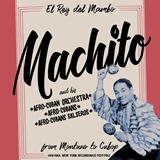
Machito
From Montuno To Cubop
Machito had arguably the most influential Big Band Latin Orchestra of the mambo era in New York, being one of the earliest, largest, and hottest. One of the most important innovations of the Orchestra was that they were the first to assemble the essential rhythmic trio of tumbadoras (congas), bongo, and timbales, which became the standard percussion lineup in subsequent Latin bands. In a bold move Machito founded and named his orchestra The Afro-Cubans in 1940, something that was unprecedented at the time, proudly calling out his heritage long before the Civil Rights movement gained momentum or James Brown would proclaim to be black and proud. The orchestra was also the first truly racially integrated and culturally diverse band in the U.S. Machito has stated that the purpose of expanding the small conjunto into the big band format was a concept that aimed to bring the Latin sound up to the current New York standards of sophistication, professionalism and excellence that the popular swing dance bands of the time enjoyed, enabling them to play complicated charts and attract plentiful multi-racial audiences to large venues. Progressive jazz-influenced arrangements were provided by his good friend and brother-in-law Mario Bauza, a clarinetist and trumpeter who had learned about sophisticated jazz composition and swing time from stints with Don Redman, Noble Sissle, Chick Webb, and Cab Calloway. This dynamic union of Machito and Bauza consequently made them key figures in the Afro-Cuban jazz/Cubop movement that came during the 1940s. What made Machito special as a vocalist was the fact that that he not only sung the "inspiraciones" (improvised sections) and lead, but he would also sing coro (chorus) in the same song. Not content to be simply a percussionist or crooner, Grillo also took part in musical timbre of his band, being a sophisticated musical thinker who knew what he wanted sonically, and how to get it, something he was not often credited with at the time. Already in his 30s when he started his big band, Machitos voice had a warm, fun-loving, pleasant sound with an old-school vibrato befitting a Broadway entertainer that by the 1950s was sounding more mature than his competitors. Yet he also was well versed in Afro-Cuban lingo and jazz vocals and fit his authentic soneos expertly into the complicated jazz riffs and tropical poly-rhythms of the orchestra.